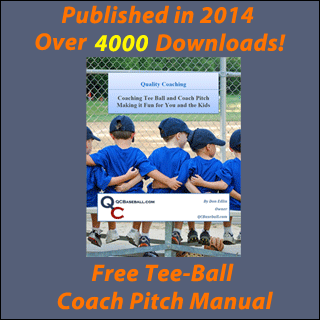Hitting - Pitcher Release Points
Now that we have the correct attitude when stepping into the box, it's time to discuss how we pick up the ball as it's pitched.
Important: You can have a flawless swing, but if you don't see the ball well, you will struggle at the plate!
Practice
Pitcher Tipping Pitches
Do you know what he's looking for when you step into the box? Where do you pick up the ball? Do you follow the ball or look in the general direction of the mound? Ask a few of your players what they look for and I'm sure you'll get a few different answers. If you are coaching a young team some of the answers will end up being "I don't know". I asked my youngest son that same question the other day and he said he just looks at the pitcher and then just watches the ball when he sees it. Now I've gone over picking up the ball out of the pitcher's hand with him so I was a little surprised that he didn't give an answer along those lines, but I think it helps demonstrate that picking up the release point isn't something you can go over once and then assume a player will remember. Picking up the ball at the earliest possible moment is a huge advantage and something that needs to be practiced on a regular basis. A hitter who is not picking up the ball out of the pitchers hand is losing valuable time in determining the location, speed, and movement of the pitch. Timing is critical to a hitter and the later he picks up the ball the less time he has to determine if he's going to swing and less time to execute his swing. Often these players will swing mainly with their arms or look fooled by a fastball. Their game swing appears different then the swing they use at practice when the pitches are slower. Certainly speed is a factor but often a player simply isn't picking up the ball early enough to adjust to game time pitching speeds. The player appears to be overmatched by the pitcher even though he's capable of hitting that speed of pitch.
Methods – There are a few different methods of picking up the release point of the pitcher and I'll cover a few which you can share with your team. As with many things each player will need to find what's comfortable for him. One thing that's important for each player to realize is that they need to know the release point of the pitcher before they step into the batter's box. Each method of picking up ball out of the pitchers hand is dependant on knowing where the hand is going to be before the pitcher starts his windup.
1. Make an imaginary box around the release point of the pitcher (Image below). As the pitcher goes into his windup the batter will look at the box and wait for the ball to appear in the box. Once the ball appears, the hitter will pick up the ball and follow it in.
a. Some players will find that it's difficult to focus their eyes in the distance through an imaginary box and then having to focus down to a shorter distance as the ball appears. For hitters who don't like to stare off into the distance, a common tactic is to pick out a part of the pitchers' body that's close to the release point and then as the ball appears in the box they shift their eyes from that part of the pitcher to the ball (Image v4 below). This means the eyes stay focused at the correct distance. It's important that the hitter doesn't focus on too small of an area. Just like the rest of the body we want to keep our eyes relaxed before trying to pick up the ball and that can't be done if the player is trying to focus on the logo of a hat or a button on the uniform.
b. Others find that looking into the distance helps keep their eyes relaxed and they are better able to then focus when needed as the ball appears in the box if they look through the box to center field as they wait for the ball to be released.
2. Most pitchers will raise their throwing arm up and back behind the body as they stride forward and deliver the pitch. This can be a good place to pick up and follow the ball. Many older pitchers do a good job of hiding the ball behind their body and heads and it can be difficult to use this method to pick up the ball when a pitcher does this. For younger players though the ball is often visible from that position through release and can be a good method of picking up the ball even before it reaches the release point.
3. Some hitters will try to follow the ball all the way from the pitcher pulling it out of the glove to the time it crosses the plate. As with the method above the main problem is a pitcher who hides the ball well right before his arm comes forward. If this is the case then it may be easier and more effective to use method 1 and 2 where a hitter is solely concerned about the release point rather than following the ball.

Players should learn various methods and use the method that they feel gives them the best opportunity to pick up the ball as early as possible. As a hitter I tended to use methods 1 and 2 depending on the pitcher. I found that a hard throwing over the top pitcher made method 2 the best for me. While a ¾ delivery pitcher made method 1 the choice for me. I found I didn't like staring off to center field and waiting for the ball to appear as in method 1 but I know other hitters I played with who felt this kept them very focused on the ball and not the motion of the pitcher.
Most Recent Blog Posts
Working With Players on Focusing on the Correct Part of the Baseball when Hitting (October 15 2016)
Getting More Accurate Throws From Your Team (April 5 2016)
I have coached rec ball for several years, but did not realize all the assistance that was out there on your website. I am now coaching a travel team and your lessons have helped so much to not only my players, but me as well. You break the game down to its simplest form that everyone can understand.
- Kevin H.







